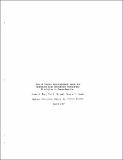Use of source apportionment model for designing acid deposition mitigating strategies in Massachusetts
Author(s)
Fay, James A.; Golomb, D.; Zemba, Stephen G.
DownloadMIT-EL-87-005-19763366.pdf (644.4Kb)
Metadata
Show full item recordAbstract
The Commonwealth of Massachusetts promulgated an Act limiting S2
emissions from large sources that burn fuel at a rate greater than or equal
to 100 million Btu (MBtu) of fuel input per hour. The Act requires that by
1995 the average emission rate at such facilities be less than or equal to 1.2
lb SO2 per MBtu fuel input. Because of their size, almost all power plants in
Massachusetts could be subject to emission reductions. Since the average
1980-1982 annual emission rate of Massachusetts power plants was 1.84 lb
S02/MBtu ("base case"), the Act requires the annual average emission rate of
power plants to diminish by 35%.
We use a source apportionment model to estimate the wet sulfate deposition
to typical sensitive Massachusetts receptors from Massachusetts power plants,
separately for the summer (April-September) and winter (October-March)
half-years. We find that the summer wet deposition is about twice the winter
deposition, although summer and winter SO2 emissions are approximately equal.
Therefore, to reduce sulfate deposition, t is more effective to reduce
emissions in the summer months rather than in winter. Using the seasonal
source apportionment model we find that an annual wet deposition reduction
equal to that resulting from the Act could be accomplished if only summer
emission rates were reduced to 0.86 lb SO /MBtu, with winter emission rates
remaining at 1.84 lb S02/MBtu. The resulging annual average emission rate is
1.35 lb SO /MBtu, 27% less than the base value. As 1980-1982 average annual
emissions rom power plants amounted to 270,000 tons of SO annually, a summer
emission control program would save about 21,000 tons of S emission
reduction without sacrificing wet deposition protection. Te summer emission
reduction could be acomplished by substituting lower sulfur content fuels,
including natural gas, for higher sulfur content fuels.
Date issued
1987Publisher
MIT Energy Lab
Other identifiers
19763366
Series/Report no.
MIT-EL87-005